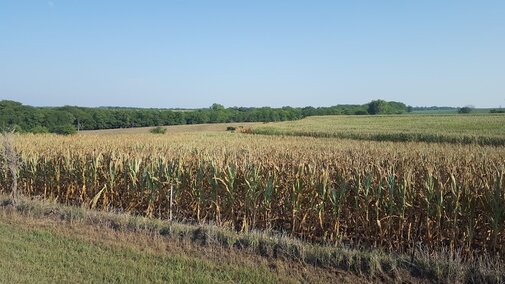Laura Thompson, Extension Educator and On-Farm Research Co-Coordinator: Precipitation in Richardson County has been below normal for most of the crop production season as indicated in the chart and by the US Drought Monitor map for Nebraska, which will likely lead to below-normal yields for many dryland fields (Figure 1). Some of these fields also had pollination issues. (7/26/18)


Sarah Sivits, Extension Educator serving Dawson, Buffalo, and Hall counties: We have hail damage in northern Dawson County (just south of Oconto), Buffalo County (Pleasanton area, Ravenna area, and Gibbon area), and maybe some in Hall county. I saw some disease pressure in corn including common rust, smut, gray leaf spot, and bacterial leaf streak. Folks are spraying for western bean cutworm or corn rootworm beetles. Some folks may have sprayed for Japanese beetles too. Fungicides have also been going on. Soybeans are setting pods, but there’s quite a few fields that are still showing herbicide injury from off-target movement. Other than herbicide damage and a little brown spot, soybeans look relatively good across the area. Lots of Palmer escapes this year in addition to volunteer corn issues. Sorghum and cane are starting to get heads; some fields of cane and corn are behind this year. Some folks have irrigated quite a bit this summer while others were blessed to get rain at the right time and haven’t turned the pivots on yet. Corn is anywhere from almost tasseling to milk stage. No sign of southern rust yet. (7/24/18)
Tamra Jackson-Ziems, Extension Plant Pathologist: This week southern rust was confirmed in corn in Thurston County. It had previously been confirmed in Fillmore, Saunders and Thayer counties. To view southern rust movement in the U.S. go to http://ext.ipipe.org or follow @corndisease on Twitter. (7/26/18)
Nathan Mueller, Extension Educator for Dodge and Washington counties: This is peak water use time for soybeans and corn. Growers here are just starting to turn on pivots and in corn, possibly to apply N, and haven't been irrigating soybeans yet. Wheat yields were 50-80 bu/ac in the area, partially due to timely rainfall. We’re seeing some gray leaf spot, bacterial leaf streak, and Goss’s wilt. We’re seeing increased defoliation from Japanese beetles, but not enough to warrant treatment. Some fields have about 10% overall defoliation. (7/24/18)
John Thomas, Extension Educator for the northern Nebraska Panhandle: The wheat stem sawfly has become a pretty significant issue for wheat growers this year. Over the last 10-15 years populations have increased dramatically. Probably 60% of our wheat has been harvested with good yields. In some fields, however, there was significant lodging, as much as 80%-90% for the first 100 feet. Damage from the wheat stem sawfly doesn’t necessarily cause lodging, but damaged wheat will lodge after heavy rain and wind storms. With really good moisture and some cooler temperatures at optimal times, yields were good despite damage from the wheat stem sawfly. Dryland wheat yields were 50-60 bu/ac, some higher.We haven’t had other significant insect issues. Our corn is looking good and most has silked. Beets and beans are looking good and we had less hail than usual this year. Beans are just moving into bloom. (7/24/18)

